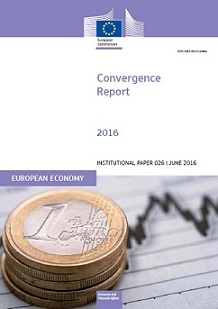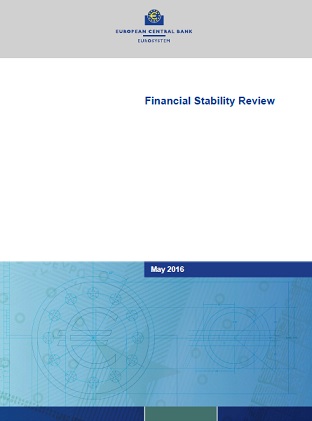European Commission, (2016), “Convergence Report 2016”, European Commission, Institutional Paper 026, Ιούνιος Convergence Reports examine whether Member States satisfy the conditions for adopting the single currency. The 2016 Convergence Report, adopted on 7 June 2016, is a regular biennial report and examines progress with convergence in seven Member States with a derogation – Bulgaria, the Czech Republic, Croatia, Hungary, Poland, Romania and Sweden. The report concludes that none of the …Read More
Business, housing and credit cycles
Rünstler, Gerhard, Vlekke, Marente, (2016), “Business, housing and credit cycles”, European Central Bank, No 1915 / June 2016 We use multivariate unobserved components models to estimate trend and cyclical components in GDP, credit volumes and house prices for the U.S. and the five largest European economies. With the exception of Germany, we find large and long cycles in credit and house prices, which are highly correlated with a medium-term component in GDP …Read More
From Antigrowth Bias to Quantitative Easing
Bibow, Jörg, (2016), “From Antigrowth Bias to Quantitative Easing”, Levy Economics Institute, Ιούνιος This paper investigates the European Central Bank’s (ECB) monetary policies. It identifies an antigrowth bias in the bank’s monetary policy approach: the ECB is quick to hike, but slow to ease. Similarly, while other players and institutional deficiencies share responsibility for the euro’s failure, the bank has generally done “too little, too late” with regard to managing the …Read More
Financial Stability Review
European Central Bank, (2016), “Financial Stability Review”, ECB, Μάιος The Financial Stability Review (FSR) assesses developments relevant for financial stability, including identifying and prioritising the main sources of systemic risk and vulnerabilities for the euro area financial system – comprising intermediaries, markets and market infrastructures. It does so to promote awareness of these systemic risks among policymakers, the financial industry and the public at large, with the ultimate goal of …Read More
Survey on the Access to Finance of Enterprises in the euro area
European Central Bank, (2016), “Survey on the Access to Finance of Enterprises in the euro area”, ECB, Ιούνιος This report presents the main results of the 14th round of the Survey on the Access to Finance of Enterprises (SAFE), which was conducted between 10 March and 21 April 2016. The total euro area sample size was 11,725 enterprises, of which 10,709 (91%) had fewer than 250 employees.1 The report mainly …Read More
OECD Economic Outlook
OECD, (2016), “OECD Economic Outlook”, OECD, Volume 2016 Issue 1, Ιούνιος The global economy is stuck in a low-growth trap that will require more coordinated and comprehensive use of fiscal, monetary and structural policies to move to a higher growth path and ensure that promises are kept to both young and old, according to the OECD’s latest Global Economic Outlook. “Growth is flat in the advanced economies and has slowed in many …Read More
Neoliberalism: Oversold?
Ostry, Jonathan D., Loungani, Prakash, Furceri, Davide, (2016), “Neoliberalism: Oversold?”, IMF Finance and Development, Volume 53 Number 2, Iούνιος Milton Friedman in 1982 hailed Chile as an “economic miracle.” Nearly a decade earlier, Chile had turned to policies that have since been widely emulated across the globe. Th e neoliberal agenda—a label used more by critics than by the architects of the policies— rests on two main planks. Th e fi rst …Read More
Έργα υποδομών Χρηματοδοτώντας το μέλλον Ελλάδα
PwC, (2016), “Έργα υποδομών Χρηματοδοτώντας το μέλλον Ελλάδα”, Μάρτιος 2016 Σύμφωνα με τον ΟΟΣΑ, οι παγκόσμιες ανάγκες* σε έργα υποδομών αναμένεται να αυξηθούν, αγγίζοντας τα $ 55 τρισ. έως το 2030. Στην Ελλάδα οι επενδύσεις υποδομών επηρεάστηκαν από την βαθιά οικονομική κρίση. Το επενδυτικό κενό σε έργα υποδομών κυμαίνεται μεταξύ 0,8πμ του ΑΕΠ (έναντι του Ευρωπαϊκού μέσου όρου) και 1,3 πμ του ΑΕΠ (σε σύγκριση με τον ιστορικό Ελληνικό μέσο όρο), …Read More
Europe 2020 indicators – poverty and social exclusion
Eurostat/Europe 2020 indicators – poverty and social exclusion/March 2016 This article is part of a set of statistical articles on the Europe 2020 strategy. It provides recent statistics on poverty and social inclusion in the European Union (EU). The Europe 2020 strategy is the EU’s agenda for growth and jobs for the current decade. It emphasises smart, sustainable and inclusive growth as a way to overcome the structural weakness in Europe’s economy, to improve its competitiveness …Read More
Lessons for the euro from early US monetary and financial history
Frieden, Jeffry, (2016), “Lessons for the euro from early US monetary and financial history”, Bruegel Essay, 25 Μαϊου Europe’s central goal for several decades has been to create an economic union that can provide monetary and financial stability. This goal is often compared to the long-standing monetary union that is the United States. Easy celebration of the successful American union ignores the fact that it took an extremely long time to …Read More








